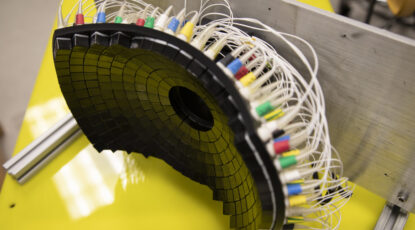Science and Technology
-
U-M researchers aim to bring humans back into the loop, as AI use and misuse rises
We’re talking about AI the wrong way, says Ross professor Nigel Melville. ‘We’re moving away from the things we want, such as better medications, elder care and safety regulations, and toward the things we don’t, like harmful deepfakes, job losses, and biased decision making.”
-
Brain health, concussions and sports: Is there a long-term connection?
The Michigan Alumni Brain Health Study will compare cognitive, mood, sleep, pain, and functional outcomes to examine whether sport participation and concussions are associated with later-life brain health in former U-M athletes and nonathletes.
-
319-million-year-old fish preserves the earliest fossilized brain of a backboned animal
The CT-scanned skull of a 319-million-year-old fossilized fish, pulled from a coal mine in England more than a century ago, has revealed the oldest example of a well-preserved vertebrate brain.
-
From Cuba to chemical engineering: ‘I’m supposed to be here’
Ph.D. student José Carlos Díaz first merged his knack for engineering and science by repairing microscopes for use in his sixth-grade class. He was 11 years old. He’s now an ion-diffusion researcher at one of the top chemical engineering programs in the U.S.
-
U-M researchers helping to develop a machine for on-demand N95 mask manufacturing
Launched with $3 million from the American Rescue Plan Act, the project aims to develop better respirators with new manufacturing processes that can be ramped up on demand, protecting both health care workers and the public.
-
U-M discovery dramatically reduces time it takes to build molecules
With a big assist from artificial intelligence and a heavy dose of human touch, U-M researchers have discovered how to speed up the time-consuming chemical process of building molecules that will be tomorrow’s medicines, agrichemicals, or materials.
-
Tracking ocean microplastics from space
Harmful microplastics — tiny flecks that can ride ocean currents for thousands of miles — are extremely difficult to track and clean up. But, it turns out these same microplastics tag along with soapy or oily residue, which satellites are great at spotting.
-
How sound waves trigger immune responses to cancer in mice
By breaking down the cell wall “cloak,” the treatment exposes previously hidden cancer cell markers and could offer patients a treatment option without the harmful side effects of radiation and chemotherapy.
-
Not hidden but modern
U-M’s first Black woman to graduate with a PhD in computer science and engineering is driving change within the University of Florida and scaling her influence with a podcast.









